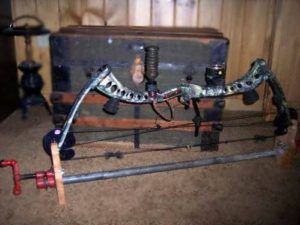- Best Archery Accessories 2024 - March 19, 2022
- Bow string:Why does it keep hitting my arm? - February 2, 2022
- Bow square: A how to guide - February 2, 2022
An essential part of any compound bow is the bow string comprising several smaller strands draped together to form a sturdy string. The bow string can withstand hundreds of pounds of force and serve you for a long time when taken care of.
On the other hand, when the bow string gets terrible, there is no proper maintenance to take care of it as it will fray, causing a safety risk as it can snap without warning resulting in appalling outcomes. Now, you can visit the archery shop to have a new bow string put on, or you can do it at home.
Here we will discuss two different methods on stringing a compound bow. One is using a bow press and the other method is using your hand.
However, before we get to how to place a new bow string on your compound bow, let us look at the bow string structure and function.
The Function and Structure of a Bow String
The bow string joins the compound bows stave’s ends and helps to launch the arrow. These days the bow string has a non-stretching structure made with man-made materials. For this reason, it starts to lose tension with time. The new bow string needs to be able to withstand abrasion, water, and be lightweight with strength.
Should You Change the String Regularly ?
When the string starts losing its strength and damage on the compound bow, it is essential to replace it with a new bow string before using it again. The reason to do a re-string is that it can result in safety issues causing damage to the compound bow and yourself when it snaps without warning. If there is no damage to the bowstring, you can re-string it every two to three years.
Cost
On average, it costs $20 but can be a bit more expensive if you went to an archery workshop to have a compound bow re-strung. You can expect to pay more for quality service, $100 to $150 to have a new string place on your bow. The next question on your mind, as we already mentioned that the string could last up to three years.
Can a String Break?
Yes, it can break for many reasons. The old string can fail due to the lack of a correct shooting form, lack of knowledge on how to wield the bow or the bow torque. On the other hand, it can be derailed or the old string breaks when used.
Right Time to Re-string?
You can inspect the bow strings periodically by paying attention to all parts of your compound bow. Inspect the bowstring and look for signs of breaks or frays. Once you notice these signs, make sure to replace them with a new string.
Also, check the string at the cam’s point for signs of damage as this is the first place where fraying occurs. If worn, replace it with a new string. On the other hand, check for damaged strings at the nock point and keep an eye on the bow’s draw length.
If the draw length is abnormally long, it is a sign that the bow s string needs replacing. On the other hand, having a bow strings diagram is also helpful when replacing a bowstring at home.
Using a Bow Press Stringer
Sometimes you need to use a bow press to string your compound bow and depends on the type of bow you have. The press does secure the bow while moving the limbs to position it correctly to replace the bowstring and safer to use.
On the other hand, you need to consider the compound bow you have to determine the type and size of bow press you need. Moreover, you need to look if the bow has a teardrop attachment to slot the string. If it does have one, you will notice it has two indentations, one on either side of the bow’s cable to attach the line.
You will need to attach the new string with such a bow while the old bowstrings are still attached. If the compound bow does not have these attachments, you can go ahead and remove the string before replacing it with a new one.

Teardrop Attachment
Start by following the instructions included with your bow press to keep your bow secure before starting with the re-string process.
Once you have the bow in the press, slide your new string loops onto the provided indentations. First, take the first ring of the string and attach it to the empty indentation on the side.
Repeat the process with the other end loop on the other bow’s limbs. Make sure that both rings are secure and carefully remove the old string from the attachments other side.
Non-Teardrop Attachment
As above, secure the bow in the bow press by following the manufacturer’s instructions. Now fasten the end ring to the right spot on the cam’s center. Take the bowstring, loop underneath the cam, and back over.
You need to secure it into the indentation. If your bow has two cams, you need to do the same thing with the other cam but do it in reverse. For a one-cam bow, you need to hoop the string to pull it around the wheel on the limb and move it back down to fasten onto the cam.
Once the string is attached, make sure that the bowstrings are properly tightened by fastening the bolts one by one. Now detach the bow from the bow press, check that the string is still secure in the indentations, and adjust accordingly.
What if you don’t have a Bow Press?
The only compound bow you can re-string without using a bow press is the older models with a teardrop attachment, and for the rest, you need a bow press. The crucial thing to remember is that without a press, removing the string can be dangerous. This is because there is tension involved during the process, causing the line to snap.
Steps to Follow for Replacement by Hand
While archery shops have great tools to re-string your bow, it can cost a fortune. Neither does everyone have the money to buy the best bow press? So all that is left for you to do is doing it by hand. You will need your new bowstring, Allen wrench, and your hands/feet.
- Start by locating the limb bolts of the bow and use the Allen wrench on them. The limbs connect the bow to the riser at the bolts.
- Start turning the bolts one after another in an anti-clockwise position to remove them from the limbs.
- Place both your feet on top of the bowstring and use your hands to pull up on the riser. Keep pulling it to allow the bow to get to a full draw position.
- With one hand, hold the riser and use the other hand to place the replacement bowstring loop on the new string open side’s attachment.
- Lower the bow until the limbs get back to the original position and look at the string’s loop to make sure it is seated fully onto the grooves.
- Place both your feet on the new bowstring and start pulling the riser until it attains the full draw again.
- Remove the old string from the fitting and lower the bow. Take the wrench to tighten the limb bolts.
PSE Bows
When it comes to re-stringing the PSE Compound Bow, you need to use an approved bow press. There are two types of approved presses available the pull-type and compression type. The preferred style is the compression bow press.
Compression
The press thrusts in a horizontal course against the incline of the limbs and needs no added support. When using the bow press, you need to back each bolt out to the max number of turns on your bow’s hangtag. Position your bow in the bow press and crank it inward, allowing for compression force against the tips. You need to compress only far enough to help loosen the string and cables.
The press pulls the bow’s riser in a vertical direction between the rollers. You need to position the rollers correctly to the pressure points. Now back each limb bolts out to the max number of turns.
Position the pressure points on the bow’s riser as close to the stem without making contact with the limbs. Now position the rollers outward on the bow’s limbs to prevent the bow from slipping when pulled down.
When placing tension, be careful to not pull the riser down too much and remove the cables and strings.
Basic Maintenance
Your bow needs caring and the same applies to the cables to prolong the use. The bowstring is the engine that drives your compound bow to propel the arrow and you need to put energy into it. To be able to achieve this you need to draw the string.
So how do you keep the bowstring maintained? The simplest way is to wax the string. But how often should you do this. It depends on different factors from how often you shoot, where do you shoot, the humidity, and more.
To prevent the string from getting dirty or it feels tacky give it some was. You can apply it every two to four weeks when used regularly or do it once a week. If you notice the strands on the bowstring stick up and getting furry it is time to apply wax.
However, if there are specific strands standing up it is time to replace the old string with a new string as it is damaged.
Break in time
These days the bowstring comes with a pre-stretched form but still needs a break-in time. To break-in your new string it helps to shoot it up to 200 times to finish the stretching. After breaking in the string, you can give it a final tune and inspection by doing it yourself or visiting a pro shop.
Final Thoughts
When you maintain your compound bow and restring it without using a bow press, always remember it is dangerous. The high tension makes it easier for the strings or limbs to snap back at you. Always keep an eye on the limbs and the bowstring as the limbs can move out of position, causing harm. After re-stringing the bow, it should feel like the old bow, and if anything is amiss, do not shoot the bow until you have sorted out the problem.
